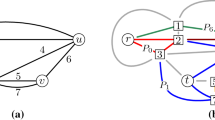Abstract
At most how many edges can an ordered graph ofn vertices have if it does not contain a fixed forbidden ordered subgraphH? It is not hard to give an asymptotically tight answer to this question, unlessH is a bipartite graph in which every vertex belonging to the first part precedes all vertices belonging to the second. In this case, the question can be reformulated as an extremal problem for zero-one matrices avoiding a certain pattern (submatrix)P. We disprove a general conjecture of Füredi and Hajnal related to the latter problem, and replace it by some weaker alternatives. We verify our conjectures in a few special cases whenP is the adjacency matrix of an acyclic graph and discuss the same question when the forbidden patterns are adjacency matrices of cycles. Our results lead to a new proof of the fact that the number of times that the unit distance can occur amongn points in the plane isO(n 4/3).
Similar content being viewed by others
References
N. Alon and E. Friedgut,On the number of permutations avoiding a given pattern, Journal of Combinatorial Theory, Series A89 (2000), 133–140.
D. Bienstock and E. Győri,An extremal problem on sparse 0–1 matrices, SIAM Journal on Discrete Mathematics4 (1991), 17–27.
B. Bollobás,Extremal Graph Theory, Academic Press, London, 1978.
P. Brass,On lattice polyhedra and pseudocircle arrangements, inCharlemagne and his Heritage—1200 Years of Civilization and Science in Europe, Vol. 2: Mathematical Arts (P. L. Butzer et al., eds.), Brepols Verlag, 1988, pp. 297–302.
P. Brass, Gy. Károlyi and P. Valtr,A Turán-type extremal theory of convex geometric graphs, inDiscrete and Computational Geometry—The Goodman-Pollack Festschrift (B. Aronov et al., eds.), Springer-Verlag, Berlin, Turnhout, 2003, pp. 277–302.
K. Clarkson, H. Edelsbrunner, L. Guibas, M. Sharir and E. Welzl,Combinatorial complexity bounds for arrangements of curves and spheres, Discrete and Computational Geometry5 (1990), 99–160.
P. Erdős and A. H. Stone,On the structure of linear graphs, Bulletin of the American Mathematical Society52 (1946), 1087–1091.
Z. Füredi,The maximum number of unit distances in a convex n-gon, Journal of Combinatorial Theory, Series A55 (1990), 316–320.
Z. Füredi and P. Hajnal,Davenport-Schinzel theory of matrices, Discrete Mathematics103 (1992), 233–251.
N. H. Katz,On the self crossing six sided figure problem, New York Journal of Mathematics5 (1999), 121–130.
A. Marcus and G. Tardos,Excluded permutation matrices and the Stanley-Wilf conjecture, Journal of Combinatorial Theory, Series A107 (2004), 153–160.
J. Spencer, E. Szemerédi and W. T. Trotter,Unit distances in the Euclidean plane, inGraph Theory and Combinatorics (B. Bollobás, ed.), Academic Press, New York, 1984, pp. 293–303.
L. A. Székely,Crossing numbers and hard Erdős problems in discrete geometry, Combinatorics, Probability, and Computing6 (1997), 353–358.
E. Szemerédi and W. T. Trotter, Jr.,Extremal problems in discrete geometry, Combinatorica3 (1983), 381–392.
G. Tardos,On 0–1 matrices and small excluded submatrices, Journal of Combinatorial Theory, Series A111 (2005), 266–288.
P. Valtr,Strictly convex norms allowing many unit distances and related touching questions, manuscript.
Author information
Authors and Affiliations
Additional information
Research supported by grants from NSF, BSF, PSC-CUNY, and OTKA (Hungar. Natonal Res. Found).
Research supported by OTKA (Hungar. Natonal Res. Found.) grants T-046234, AT-048826 and NK-62321.
Rights and permissions
About this article
Cite this article
Pach, J., Tardos, G. Forbidden paths and cycles in ordered graphs and matrices. Isr. J. Math. 155, 359–380 (2006). https://doi.org/10.1007/BF02773960
Received:
Issue Date:
DOI: https://doi.org/10.1007/BF02773960




